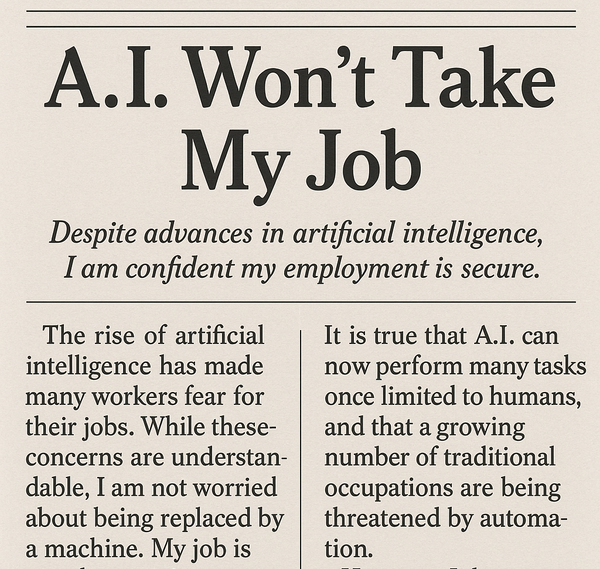Dogs not barking: the quiet crisis nobody's talking about
84% burnout, AI bloodbath, and why I'm not really a designer anymore

Why you’re getting this: This is a friend-first newsletter. Faangboss is a weave of three essential threads: the craft of design, the art of influence, and the journey of growth in UX. I poke at connective tissues, drawing from my 20+ years of launching products and mentoring designers in tech NYC.
This article has a companion podcast clip RSS feed | Spotify | Youtube | Apple
🐕 "Dogs not barking" is corporate-speak for what keeps you up at night—the topics everyone's quiet about but should be screaming from the rooftops.
Let's unleash them.
🐕 Tell us how you really feel 🐕
8,200 tech workers spilled their guts in a sentiment survey, and surprise, surprise:
- 84% are burned out (design takes the crown at #1)
- Women are 3% more burned out than men
- 50.8% are pessimistic about their future
- 37% have no clue where their career is headed

I checked five boxes on that burnout bingo card: Design, research, growth, marketing, and product. Yeah, I'm collecting roles like Pokémon cards.
I recently tried to explain what I actually do and failed miserably. Let me try again:
I work on Amazon Seller Experience. My focus? Brand owners—the businesses who own the intellectual property behind their products. This segment could be any business of any category, globally, with wide range of revenue from $250K to millions.
Looking across these business performances, we enable growth in sales for these sellers and Amazon. Enabling growth could mean surfacing programs, optimizing, or providing business strategy at the right time. We have to influence customer experiences to drive seller experiences across team, org, and challenge assumptions of traditional ways of working.
The goals we typically work on looks like "enable 350% increase from $300 million to $2 billion."
I'm no longer a designer in a traditional sense. I don't apply next gen animations, prototypes, or visual polish not because I don't have the skills or wish to do. It's not how Amazon operates. Ever since I've worked here, I haven't seen an inspiring UI with fit and finish, because that extra mile is often cut out due to frugality with the least amount of effort for maximum return.
The skills that matter now? MBA-level strategy and the ability to deliver "think big" ideas with minimal resources. Welcome to design in 2025. 🎭
🐕 Performance Management 🐕
We have a new terminology. "Performance management" or "impact driven performance" from Meta, Microsoft, corporate alike. Same wolf, different sheep's clothing.
- Only top performers get the 5-10% raises
- To qualify? You need 3-4 consecutive years of "Top Tier" ratings
- 90% of employees will get lower compensation because maintaining that streak without promotion is impossible.
Let me translate the definition of deliberate attrition:
- Score "Top Tier" for just one year? Congrats, you're making 70% of what you could
- No promotion path due to narrowing roles available = terminal on your career
- We're now competing with our own teammates for better projects
Earlier this year, Amazon cut 13k middle management roles to flatten hierarchy to foster more innovation, so IC have a shorter lifecycle to deliver more.
Corporate Squid Game 🦑 source from Amazon's New Pay Structure Shifts Focus to Top Performers Only, Leaving Others Behind - CTOL
🐕 White-collar AI bloodbath 🐕

The CEO of Anthropic dropped this cheerful prediction: Half of entry-level white-collar jobs will shrink by 10-20% in the next 1-5 years.
If we don't start talking about government policies, regulations, and what this means for society, I'm legitimately concerned about where we're headed.
🐕 AI roles are exploding because it's a vibe? 🐕
Growth is insane for AI PM roles at AI-driven companies (e.g. Cursor, Lovable), and non-AI companies (e.g. Figma).
Capital investment rankings tell the story of where the money is going:
- Meta
- Microsoft
- Amazon
So we're accelerating the growth of building things, but building things take insanely long because people who are paid to make decisions don't make them.
It's faster to build Empire State building (1y 45d) than to launch a brand new homepage. 🤨

So what can we actually do?
There's two choices.
Option A: Get scary good at business strategy, designer/PM hybrid. Learn to speak MBA fluently. (me)
Option B: Become a vibe coder/designer hybrid. If you can't beat the robots, join them.
Either way, document everything. Keep your resume fresh and portfolio ready, because who knows when an AI agent will randomly select your name for the next "restructuring."
In chaos, invest in foundations, it is the soul of jobs to be done: Premium Edition: How to design innovation - video
Case study example: Figma

Figma released this useless update... Figpals—a Tamagotchi companion that provides emotional support. I love a digital pet as much as the next millennial, but they raised prices to $20/month in March and are trying to charge per seat for everyone who so much as glances at a file.
While engineering burned cycles on cursor companions, vibe-coding tools are eating Figma's lunch.
I don't get how this provides incremental value or the fact that it's more expensive makes me more angry.
What dogs are keeping you up at night? Hit reply and let's talk about the things nobody wants to say out loud.
Why would you want to subscribe? Well, why wouldn't you? If you like this content, consider supporting me, your independent writer with a coffee. ☕️
Have a great week ahead,






